How high can Bulldogs jump?
Welcome to the captivating world of Bulldogs, where their irresistible wrinkled faces and stocky builds have stolen the hearts of many. But amidst their seemingly laid-back nature lies a burning question – just how high can these lovable canines actually jump? As an expert in all things Bulldog-related, I’m here to unravel this mystery and provide you with an informative yet exciting account of their vertical prowess.
While Bulldogs are often associated with low activity levels and a preference for lounging rather than leaping, don’t be fooled. These furry friends possess a surprising ability to defy gravity, albeit within certain limits. While they may not soar like champion agility dogs, Bulldogs have been known to showcase their jumping abilities in various situations – from playful leaps in the backyard to impressive feats of agility in organized competitions.
So buckle up as we embark on an exhilarating journey through the hidden world of Bulldog jumps. Get ready to be amazed by their unexpected athleticism and discover the unique factors that influence their jumping abilities.
Whether you’re a devoted Bulldog owner, a curious canine enthusiast, or simply seeking knowledge about these delightful creatures, this blog post is your ultimate destination for all things Bulldog jumping-related. Let’s dive in and uncover the secrets behind their aerial talents.
Understanding the Physiology of Bulldogs: Why Do They Have Trouble Jumping?
Contents
- 1 Understanding the Physiology of Bulldogs: Why Do They Have Trouble Jumping?
- 2 The Average Height a Bulldog Can Jump
- 3 Factors Affecting a Bulldog’s Ability to Jump
- 4 Activities Suitable for Bulldogs Instead of Jumping
- 5 How to Prevent Injury When Letting Your Bulldog Jump
- 6 Alternatives to Letting Your Bulldog Jump
- 7 Exercise Tips for Bulldogs and Their Owners
- 8 Conclusion
Bulldogs have a unique anatomy and physiological characteristics that make jumping a bit challenging for them. In this article, we will explore why Bulldogs have difficulty jumping and what you can do to ensure their safety and well-being.
Brachycephalic Facial Structure:
One of the main reasons Bulldogs have trouble jumping is their brachycephalic (short-snouted) facial structure. This adorable feature affects their overall breathing and respiratory system, making physical exertion more challenging for them. Bulldogs have smaller nostrils and a narrower windpipe, which can lead to breathing difficulties during strenuous activities like jumping.
Compact and Muscular Build:
Bulldogs are known for their compact and muscular build, which gives them their signature stocky appearance. However, this body structure also results in limited flexibility and range of motion in their joints. The hind legs of Bulldogs are positioned farther back on their bodies, making it harder for them to generate enough power to jump.
Heavy Body Weight:
Another factor that contributes to Bulldogs’ difficulty in jumping is their heavy body weight. Bulldogs tend to be heavier than average due to their dense bone structure and well-developed muscles. The extra weight puts additional pressure on their joints and makes it harder for them to propel themselves off the ground.
Respiratory Issues:
The brachycephalic nature of Bulldogs can also lead to other health issues, such as respiratory problems and overheating. These conditions further limit their ability to engage in strenuous physical activities like jumping. It’s essential to keep Bulldogs cool and provide plenty of water during exercise to prevent overheating.

How High Can Bulldogs Jump?
Bulldogs are not known for their jumping abilities. On average, Bulldogs can jump around 1 to 2 feet high. However, this may vary depending on factors such as the individual dog’s size, age, and overall fitness level. It’s important to note that Bulldogs are more suited for activities that require strength and stability rather than agility and jumping skills.
Tips for Bulldog Owners:
As a responsible Bulldog owner, it’s crucial to understand the limitations of your breed when it comes to jumping. Here are some tips to ensure your Bulldog’s safety and well-being:
- Provide alternative means of access: If your Bulldog tries to jump onto furniture or other elevated surfaces, consider providing them with ramps or stairs. This will prevent unnecessary strain on their bodies and reduce the risk of injuries.
- Focus on low-impact exercises: Regular exercise is still essential for Bulldogs to maintain a healthy weight and overall well-being. Engage in activities like walking, swimming, or playing fetch, which are more suitable for their unique physiology.
The Average Height a Bulldog Can Jump
When it comes to jumping, bulldogs, including French Bulldogs, are not exactly known for their high-flying abilities. Their heavy and muscular bodies, combined with short legs and a low center of gravity, make it challenging for them to jump to great heights.
On average, bulldogs can jump up to 2 feet in height, but this can vary depending on factors such as size, age, and physical condition.
It’s important to note that while some bulldogs may be able to jump higher than others, they are generally not considered a breed known for their jumping prowess. Bulldogs are more renowned for their strength and endurance rather than their agility or leaping abilities.
However, due to their body structure and potential joint issues, it’s essential to approach jumping exercises or activities with caution. Always consult with your veterinarian before engaging in any jumping activities with your bulldog to ensure it is safe for their health.
Instead of focusing on jumping, there are other activities that can better suit your furry friend’s abilities and keep them entertained. Here are a few recommendations:
- Brisk walks: Bulldogs love going for walks. This low-impact exercise helps keep them active and strengthens their muscles without putting excessive strain on their joints.
- Swimming: Bulldogs are natural swimmers. Take advantage of their love for water and let them enjoy a refreshing swim. Swimming is an excellent exercise that works the entire body while being gentle on the joints.
- Strength training: Bulldogs have impressive strength, so why not harness it? Engage in activities that focus on strength training, such as tug-of-war or using a sturdy rope toy for them to pull against.
- Mental stimulation: Bulldogs are intelligent dogs that need mental stimulation as much as physical exercise. Invest in puzzle toys or engage in regular training sessions to keep their minds sharp and active.
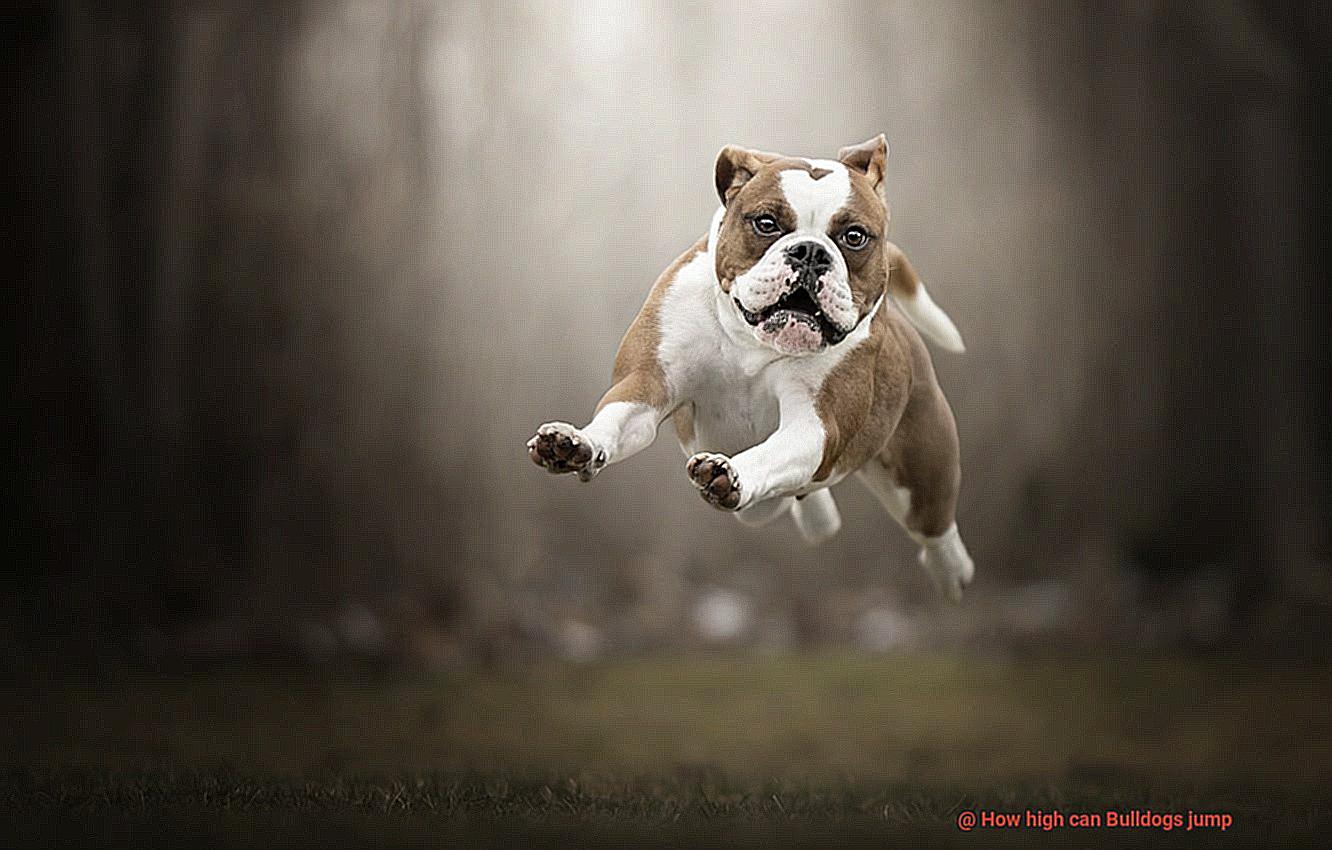
Factors Affecting a Bulldog’s Ability to Jump
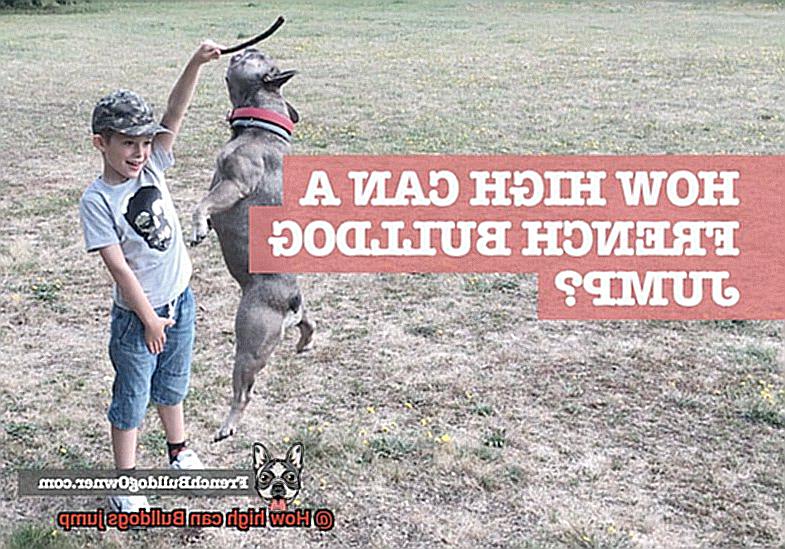
Jumping is not a bulldog’s strong suit, but that doesn’t mean they can’t have fun and engage in physical activities. Bulldogs may not be able to leap over tall buildings in a single bound like Superman, but they have their own unique set of skills and abilities. So, what factors affect a bulldog’s ability to jump? Let’s dive into the nitty-gritty details.
- Body Structure: Bulldogs are built like little tanks, with a heavy and muscular body. Their low center of gravity makes it harder for them to generate the power needed for high jumps. It’s like trying to launch a battleship into the air – it takes a lot of effort.
- Size and Weight: Bulldogs are compact dogs, weighing around 40-50 pounds on average. Their size and weight can limit their jumping ability. They may struggle to lift their bodies off the ground due to their muscular build.
- Age and Health: Just like humans, a bulldog’s age and overall health can impact their jumping prowess. Older bulldogs or those with health conditions like arthritis or joint problems may have reduced mobility and strength, making it difficult for them to reach new heights.
- Muscle Tone and Strength: Bulldogs need strong muscles, especially in their hind legs, to propel themselves off the ground when jumping. Regular exercise and physical activity can help improve muscle tone and strength, enabling them to jump higher.
- Training and Conditioning: Bulldogs can benefit from training exercises that focus on increasing their jumping abilities. Teaching them to jump over low obstacles or rewarding them with treats for jumping can strengthen their muscles and improve their jumping skills over time.
- Genetics: Some bulldogs may have a natural inclination for jumping higher than others due to their genetic traits inherited from their parents. However, genetics alone don’t determine a bulldog’s ability to jump – other factors play a significant role too.
- Confidence and Motivation: Bulldogs are known for their laid-back and relaxed demeanor. Their level of confidence and motivation can influence their willingness to jump and how high they can jump. Some bulldogs may be more adventurous and willing to attempt higher jumps, while others may prefer to keep all four paws on the ground.
Activities Suitable for Bulldogs Instead of Jumping
When it comes to activities suitable for Bulldogs instead of jumping, there are plenty of options that can keep your furry friend entertained and active. Here are some expert recommendations to ensure your Bulldog stays happy and healthy:
- Walking: Bulldogs may not be Olympic high jumpers, but they sure love a good stroll around the block. Regular walks not only provide physical exercise but also mental stimulation as they get to sniff out new scents and explore their surroundings. Aim for daily walks in safe and secure areas like parks or quiet neighborhoods.
- Swimming: Bulldogs have a natural affinity for water, and swimming is a great low-impact exercise that is gentle on their joints. Not only does it provide a full-body workout, but it also helps keep them cool during hot weather. Just make sure to supervise them while swimming, especially if they’re not experienced swimmers.
- Interactive Games: Mental stimulation is just as important as physical exercise for Bulldogs. Engage them in interactive games like puzzle toys or treat-dispensing toys that require problem-solving skills to retrieve treats. This will keep their minds sharp and prevent boredom.
- Training Sessions: Bulldogs are smart cookies, so why not put their intelligence to good use? Teach them basic commands or fun tricks to strengthen the bond between you and your furry companion. Training sessions provide mental stimulation and physical exercise, all rolled into one.
- Breed-Specific Toys: Bulldogs have strong jaws and love to chew, so invest in durable toys designed specifically for their breed. Tug ropes or chew toys can satisfy their natural chewing instincts and provide hours of entertainment.
- Socialization: Bulldogs are social butterflies and enjoy the company of other dogs. Organizing playdates or visiting dog parks can give them the opportunity to interact with their canine pals and engage in playful activities. Remember to supervise these interactions to ensure everyone’s safety.

How to Prevent Injury When Letting Your Bulldog Jump
Bulldogs may not be the best jumpers, but it’s important to take precautions to keep them safe and prevent injuries. Bulldogs have a unique body structure, with short legs and a heavy build, making excessive jumping risky. By following these tips, you can provide a safe environment for your bulldog to enjoy jumping without the worry of injury.
Create a Safe Environment:
When allowing your bulldog to jump, make sure the area is clear of obstacles and hazards. Remove any sharp objects or furniture edges that they could land on and get injured.
Consider the Height of the Jump:
Avoid encouraging your bulldog to jump from high surfaces like beds or sofas. This can strain their joints and increase the risk of injuries. Provide steps or ramps for them to climb up and down from elevated surfaces.
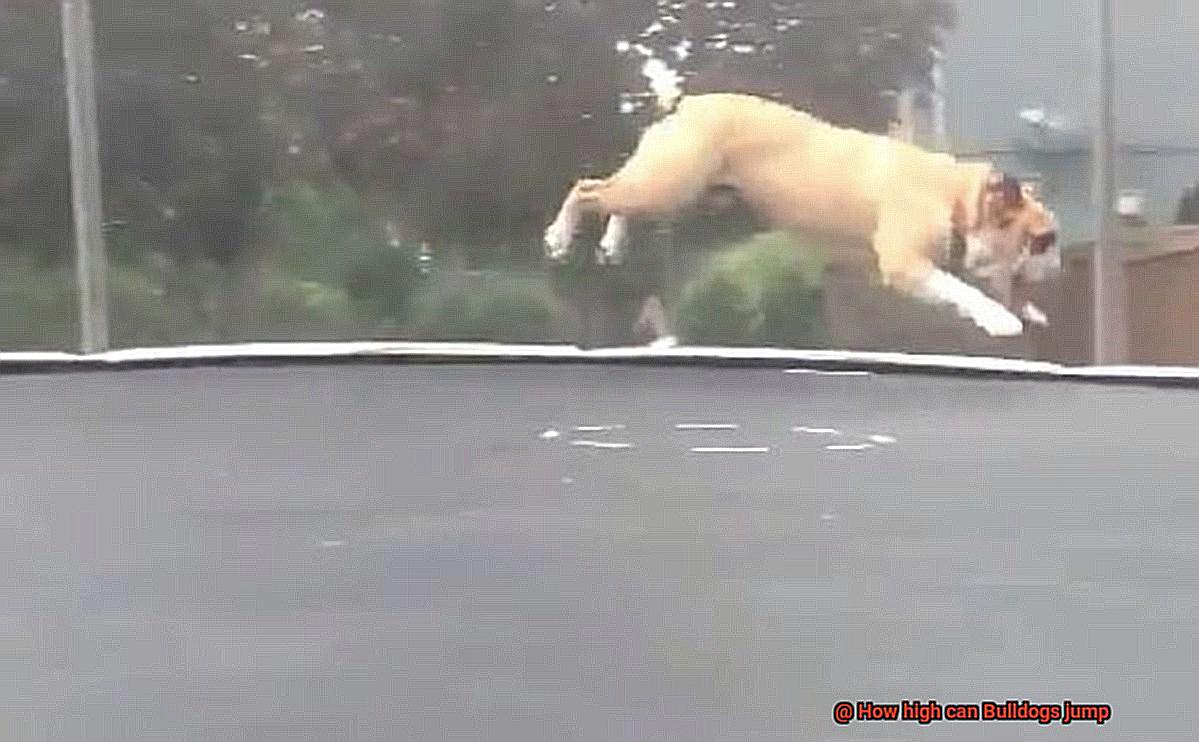
Exercise and Conditioning:
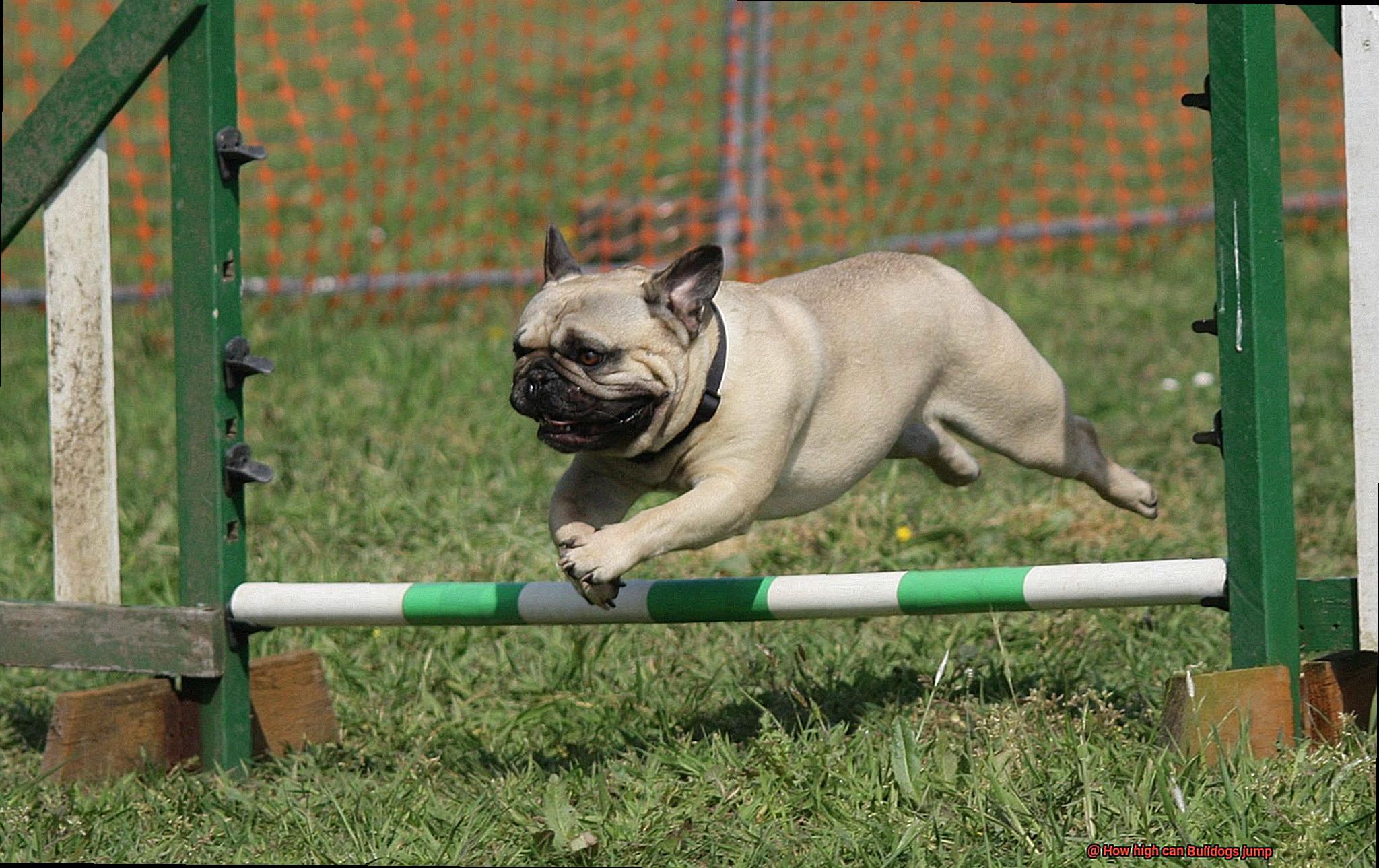
Regular exercise and conditioning are crucial for strengthening your bulldog’s muscles and joints. Engage in low-impact activities like walking or swimming to keep them active without putting too much stress on their bodies.
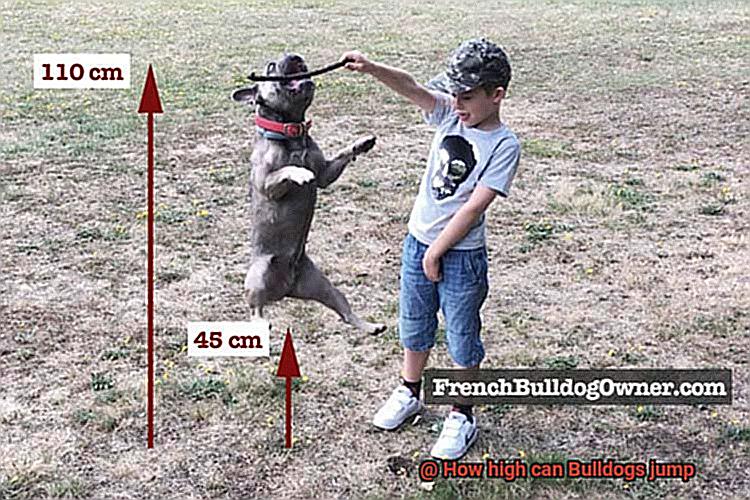
Monitor Weight:
Maintaining a healthy weight is essential for preventing injuries in bulldogs. Excess weight can strain their joints, making them more susceptible to injuries. Ensure a balanced diet and regular exercise to help them maintain a healthy weight.
Observe Signs of Discomfort:
Pay attention to any signs of discomfort or limping after your bulldog has jumped. Bulldogs are stoic animals, so they may not show obvious signs of pain or injury. If you notice any issues, seek veterinary attention promptly.
Alternatives to Letting Your Bulldog Jump
As much as we love to see our French Bulldogs jump, it’s important to keep in mind that their bodies aren’t built for high-flying adventures. With their short legs and heavy chest, Bulldogs are prone to joint issues and injuries when they jump.
So, what can you do to keep your furry friend safe and still provide them with the exercise and mental stimulation they need? Here are some alternatives to letting your Bulldog jump:
- Provide ramps or stairs: Investing in ramps or stairs can help your Bulldog navigate elevated surfaces like beds, sofas, or cars without putting unnecessary stress on their joints. These handy tools make it easier for them to access these areas safely.
- Teach commands: Teaching your Bulldog commands such as “up” and “down” can guide them onto and off of furniture or other elevated surfaces. This can help prevent them from attempting to jump and potentially injuring themselves.
- Low-impact activities: Engaging your Bulldog in low-impact activities like swimming or walking on a leash can provide exercise without the risk of jumping. These activities help maintain their physical fitness and prevent weight gain, which can exacerbate joint issues.
- Enrichment activities: Providing your Bulldog with appropriate toys and enrichment activities can redirect their energy away from jumping. Puzzle toys, treat-dispensing toys, or interactive games can keep them mentally stimulated and physically engaged.
- Regular veterinary check-ups: Bulldogs are prone to certain health issues that may affect their mobility. Regular veterinary check-ups are essential for monitoring their overall health and addressing any concerns promptly, ensuring they stay active and avoid unnecessary jumping.
- Create a safe environment: Remove any obstacles or hazards that may encourage jumping. Secure fences, gates, or barriers can prevent them from attempting to jump over them. Additionally, providing comfortable and supportive bedding can minimize the need for jumping onto furniture for rest or sleep.
Exercise Tips for Bulldogs and Their Owners
If you’ve ever seen a Bulldog in action, you know that they are not the most athletic or agile breed out there. Their stocky build, short legs, and adorable wrinkles make them more suited for lounging around than jumping over obstacles. But have you ever wondered just how high Bulldogs can jump?
Well, let me tell you the truth – Bulldogs are not known for their jumping abilities. While some Bulldogs may surprise you with a small hop or two, their average jumping height is only around 1 to 2 feet. That’s right, not very high at all.
You see, Bulldogs have a unique body structure that affects their jumping capabilities. Their short legs and compact body make it difficult for them to generate enough power to jump high. Unlike some other breeds that are known for their agility and leaping skills, Bulldogs are more suited for activities that require strength and stability, like pulling carts or participating in weight-pulling competitions.
Jumping too much or from great heights can put a strain on a Bulldog’s joints and spine, increasing the risk of injuries. That’s why it’s important for owners to be mindful of this and not encourage or force their Bulldogs to jump beyond their capabilities.
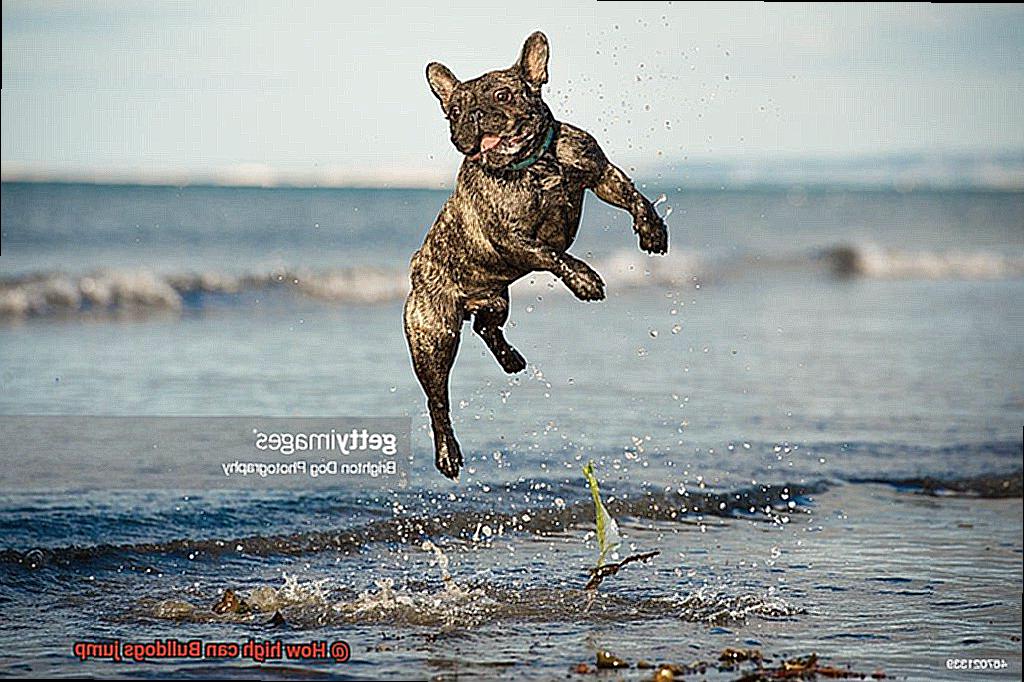
If you notice that your Bulldog is attempting to jump onto furniture or other elevated surfaces, it’s best to provide them with alternative means of access, such as ramps or stairs. This will help prevent unnecessary strain on their bodies and keep them safe.
Remember, Bulldogs are not built for jumping high, but that doesn’t mean they can’t enjoy other forms of exercise. Regular physical activity is still crucial for their overall health and well-being. Engaging in activities like walking, swimming, or playing fetch can be beneficial for their fitness levels without putting excessive stress on their joints.
w7mVp0UVAtw” >
Conclusion
In conclusion, Bulldogs may not be known for their acrobatic prowess, but they possess a surprising knack for jumping within certain boundaries. Their distinctive anatomy and physiological traits, including their brachycephalic facial structure, compact and muscular physique, substantial weight, and potential respiratory challenges, can pose some hurdles when it comes to leaping. On average, Bulldogs can achieve heights of around 1 to 2 feet.
While soaring through the air may not be their forte, Bulldogs have an array of alternative activities that keep them engaged and energized. Taking leisurely strolls, indulging in refreshing swims, partaking in interactive games, engaging in training sessions, and mingling with fellow furry friends are all excellent options that provide mental stimulation and physical exercise without subjecting their bodies to excessive strain.
When allowing your Bulldog to jump or partaking in any physical endeavor with them, it is crucial to establish a secure environment by eliminating obstacles or hazards. Furthermore, monitoring their weight and overall well-being plays a pivotal role in preventing injuries. Regular veterinary check-ups prove invaluable in promptly addressing any concerns that may arise.
Remember that Bulldogs possess an array of unique talents beyond jumping. Embrace their strength and endurance while offering appropriate exercise choices tailored to their individual needs.




